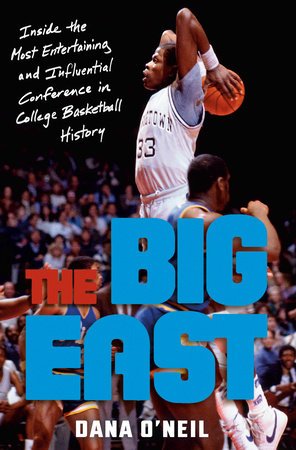Book Review: The Big East by Dana O'Neil
In April of 2008 I had a somewhat uncomfortable phone call with my Jewish grandmother explaining why I had ultimately decided to go to college at Pitt rather than Brandeis. I justified this choice to her by blathering on about the strength of their economics program for a few minutes while assiduously hiding that the true driver was the fact that I had become enamored with the Pitt Panthers’ basketball squad. And in my defense the team was coming off a riveting Big East Tournament championship and played a beguilingly tough and scrappy brand of basketball that embodied “the old Big East” of the 80’s. I was only a few weeks removed from seeing Pitt top Marquette in the Big East Tournament semifinals at Madison Square Garden and from that point on it was clear that Brandeis had no shot with me. Dana O’Neil’s new book The Big East is an engaging love letter to the glory days of the league and the colorful players and coaches who transformed it from a ragtag group of eastern colleges to a collegiate basketball powerhouse.
The Big East is still operational and is not involved kind of “Ship of Theseus” situation: key members from the league’s heyday such as Georgetown, UConn, Villanova, and St. John’s still play in the conference and Madison Square Garden remains the site of their annual tournament. However, the Big East was still decimated by conference realignment musical chairs and lost behemoths such as Syracuse and Louisville and the league is now far less relevant than it was in its heyday. O’Neil’s book covers the beginnings of the league through the realignment in the early 2010’s, putting particular emphasis on the league in the late 80s and early 90s when the Big East boasted the biggest players and coaches and their teams were mainstays in the national championship game.
The league was initially formed in response to a change in the NCAA basketball tournament seeding policy in 1979 which required schools to play in a round robin format with regional schools. This provided a big incentive for regional powerhouses like Georgetown and Syracuse to group together to have more impressive schedules for the selection committee. Guided by their visionary commissioner Dave Gavitt, bolstered by a fortuitous television contract with an upstart network called ESPN, legendary coaches including John Thompson at Georgetown and Jim Boeheim at Syracuse, and a once-in-a-lifetime talent in Patrick Ewing, the Big East became the center of the college basketball universe in the 80’s, with half of the national championship games of the decade featuring at least one Big East team.
O’Neil profiles all of the key parties involved in the rise of the league, focusing mainly on coaches including Boeheim, Thompson, and UConn’s Jim Calhoun and officials such as commissioners Dave Gavitt and Mike Tranghese. O’Neil has covered college basketball for decades and is currently a Senior Writer for The Athletic and she was able to leverage her inevitably hefty rolodex for this project and conduct over 60 interviews with Big East luminaries, including John Thompson shortly before his death in 2020. There is more limited participation from former players, and while Patrick Ewing and a handful of others including Allen Iverson and Ray Allen get some attention it doesn’t seem like any of the three were interviewed for the book and O’Neil’s player interviews mainly come from role players. I didn’t have an issue with that, however, especially given that coaches were the only true constants over the years and legends such as Boeheim, Thompson, Calhoun, and Lou Carneseca at St. John’s played a tremendous role in catapulting their teams to national prominence and in general got there from stressing team basketball rather than riding a single transformative player.
The book proceeds in a mostly chronological fashion but each chapter centers around a given team. O’Neil checks all of the major Big East boxes, with substantial sections on all of the most successful teams and coaches of the period. I’d estimate that about three-quarters of the book covers the league’s history through the UConn 1996 championship team. After O’Neil chronicles the 2003 Syracuse national championship she largely runs through the remainder of the league’s history through realignment, though she does touch on the marathon six-overtime 2009 Big East tournament game between Syracuse and UConn.
While I grew up in the 2000s and would have appreciated more pages devoted to that period in the Big East’s history, the league was slightly less relevant during the period and I feel that books like The Big East that chronicle long time periods aren’t always great at recapping recent history. A lot of those memories are fresh in readers’ heads and there may not be much new material to mine there. Fans of some smaller schools may feel like they got short shrift due to O’Neil structuring chapters around teams rather than years (“Send it in Jerome!” only gets a passing mention and Pitt and the teams that joined the conference later such as Notre Dame barely get any attention) but I can’t fault that decision too much. The book flows well and didn’t feel too short or long. This was clearly a labor of love for O’Neil and it was an entertaining reflection on a remarkably tough (I found it amusing albeit not incredibly surprising that the Big East toyed with adding an extra foul before ejection) and special league and period in college basketball. Overall, The Big East is an enjoyable and nostalgic look at the Big East’s golden years and a worthwhile read for any college basketball fan wanting to remember or learn more about college basketball in the 80’s and 90’s.
8/10

